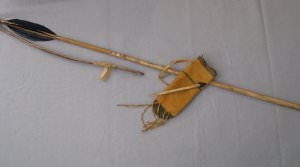There are three main requirements for human and animal life on the High Plains and Rocky Mountain Piedmont: Water, food, shelter. Following the PaleoIndian Stage of ca.13,000-7800 years Before Present, the Archaic Stage (ca. 7800-1800 years Before Present) people expanded their territories. Their population increased as they migrated, following the resources for their subsistence. The Archaic Stage is characterized by the transition from large, now extinct animals such as mammoth, camel and sloth to smaller aminals. This Stage represents a dramatic change for the big game hunters and their tool kit reflects this change. The climate change from Ice Age to moderates temperatures and moisture, however gradual, signaled a significant environmental adaptation for the plants and animals. The Archaic people had to adapt their food selection and their technology to the new species of food resources. The Archaic Stage is divided into the Early, Middle and Late periods. The Early Archaic Period, ca. 7800-5500 B.P., is separated into three parts with two periods of hot and dry climate divided by a more temperate and moist interval (Benedict 1979). Few Early Archaic sites are found in the Front Rande due to several factors, including years of refuge where the people moved from the hot, dry plains into the cooler mountains during the drought years called the Altithermal. The Altithermal episodes are ca.7000-6500 B.P. and ca.600-5500 B.P. Life for the Early Achaic people exhibits increased use of firepits, basin houses and storage pits. Modern bison, deer, pronghorn and elk were some of the large animals they hunted. Rabbits and other small mammals were consumed as were a wide variety of plants. During the episodes of the Altithermal, the people likely retreated into the foothills and mountains, following the animal and plant groups that could not survive the drought of the plains.Their migrations kept them from forming permanent settlements. However, the basin houses found at the Rueter-Hess Reservoir during archaeological investigations are indicative of longer occupations. Rockshelters are another area used for shelter. Grinding stones for vegetal processing saw increased use. The size of projectile points decreased. Lance and atlatl projectile points are indentified as large side-notched and corner-notched (Gantt 2007). The notches for binding the points to wooden shafts were an innovation in the Early Archaic Stage (Frison 1991). In the Middle Archaic Period, ca. 5500-3800 B.P., climate moderated to more cool and wet conditions. People stayed longer on the plains. Although these hunter-gathers were still mobile, they stayed in one place longer and families grew. Rockshelters and basin houses were in use. There are more known and recorded sites that these people occupied as well as more artifacts. More milling stones are found. Stemmed, indented-base projectile points as well as side-notched points are found as are drills, scrapers for processing hides. Gravers and knives are in the tool kit. The Late Archaic Period (ca.3800-1850 B.P.) characteristics are mainly a continuation of the previous periods. People migrated seasonally, moving to ripening plant communities and following migrating animal herds. Large side-notched points were still used but also smaller, corner-notched and serrated dart points are found in archaeological sites of this period. Grinding tools are more abundant. Shelter structures were consistent with earlier periods and more sites are found, signaling higher populations. This exhibit features the types of stone tools that were used in this long period of time. References: Benedict, James B. 1979. Getting Away From It All: A Study of Man, Mountains, and the Two-Drought Altithermal. Southwestern Lore. Gilmore, Kevin P. et al. 1999. Colorado Prehistory: A Context for the Platte River Basin. Colorado Council of Professional Archaeologists. Frison, George C. 1991. Prehistoric Hunters of the High Plains, Second Edition. Academic Press, Inc. San Diego, California. Gantt, Erik M. et al. 2007. Mitigative Excavations at the Hess..., Oeskeso..., (and other) Archaeological Sites at the Rueter-Hess Reservoir, Douglas County, Colorado. Vols. I and II. Centennial Archaeology, Ft. Collins, Colorado. Various Authors. 2003. Final Environmental Impact Statement: Rueter-Hess Reservoir. Vols. I and II. Prepared for: U.S. Army Corps of Engineers, Omaha District. Omaha, Nebraska. By URS. Denver, Colorado.
